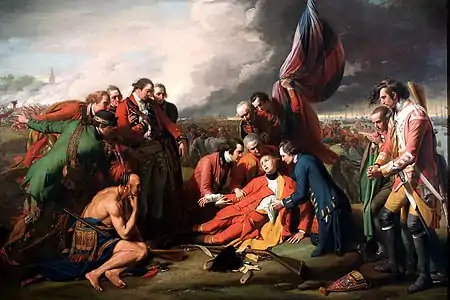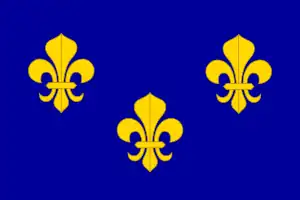| |||||
| Decades: |
| ||||
|---|---|---|---|---|---|
| See also: | |||||
| Part of a series on the |
| History of Canada |
|---|
 |
| Timeline (list) |
| Historically significant |
| Topics |
| By provinces and territories |
| Cities |
| Research |
Events from the year 1731 in Canada.
Incumbents
Governors
Events
- 1731: Fort St. Pierre on Rainy Lake established by Christopher Dufrost de La Jemeraye and Jean Baptiste de La Vérendrye. This was the first fort in La Verendrye's expansion of the "Posts of the West".
- 1731-43: The La Verendrye family organize expeditions beyond Lake Winnipeg and direct fur trade toward the east.
Births
- Richard Dobie, an early Canadian businessman and a sometimes partner of Benjamin Frobisher (died 1805).
- November 7: Robert Rogers, army officer and author (died 1795).[3]
Deaths
- Robert Chevalier Beauchêne, adventurer in New France.[4]
Historical documents
Pennsylvania lieutenant governor forwards 1718 study of French trade routes and "their Indians" and means to "prevent the designs of the French"[5]
Pennsylvania lieutenant governor says his province and New York worry French are co-opting their frontiers and Indigenous people on them[6]
New York vulnerable to French, who have fort at Crown Point, priests, and "people that runn amongst the Indians and are much like them"[7]
New Hampshire survey finds "no Indians" in N.H. and some in eastern Massachusetts, and "extreamly numerous" French in Canada and Cape Breton[8]
How Newfoundland fits into trade network of Middle Atlantic colonies, Indigenous people, Britain, Spain, Portugal and West Indies[9]
Board of Trade advised that Newfoundland justice of the peace and fishing admiral have distinctly different powers, with former superior to latter[10]
"The ignorant people are possess'd" - Clout of fishing admirals and others makes enforcement formidable for Newfoundland governor and justices[11]
"The fear we are in" - Newfoundland justices of the peace characterize Irish Catholics and transported felons as especially dangerous[12]
Nova Scotia has few English (besides military), no Blacks and about 800 Acadian families, who "are increas'd near one half" in 10 years[13]
To avoid settlement delay, Nova Scotia leadership suggests simultaneous survey of forests reserved for Navy and land to be open to settlers[14]
Nova Scotia acknowledges dependence on French currency and Boston paper money, and limited food resources with settlers expected[15]
Nova Scotians claiming land that is unworked must show why it should not be disposed of for benefit of Crown and "fresh settlers"[16]
"Ungovernable people" - Lieutenant governor distrusts holders of old French land grants, and thinks Acadian justices would inform on rest of Acadians[17]
Nova Scotia Council agrees unanimously that Boston company should be allowed to mine coal at site near Cape Chignecto[18]
Preponderant New England property owners prevent proper settlement in Canso, and thus schooners prevail over in-shore fishing[19]
Canso fishery also varies from Newfoundland's because no inhabitants are involved (except in salt curing) and no servants nor soldiers fish[20]
Prompted by 1731 Nova Scotia letter, Board of Trade notes "complaints of the very bad manner in which the Canso fish is cured"[21]
Armstrong informs Council of his instructions "forbiding laying any Duty on Negroes or ffelons [sic] imported into this province[22]
Surveyor of His Majesty's Woods in Maine finds "gentry" have "stragling manner of settlement" that provokes "insults of the Indians"[23]
Dunbar warns "Indian deeds" imply "ye Indians have a right to dispose of all ye rest of ye lands" (while they say lands are inalienable)[24]
Decision coming on Massachusetts claim to Nova Scotia land west of Penobscot River, but Dunbar should still add settlements east of there[25]
Tract of land between Kennebec and St. Croix rivers determined to be under government of Massachusetts, and settler land claims there valid[26]
References
- ↑ Guéganic (2008), p. 13.
- ↑ "George I". Official web site of the British monarchy. 30 December 2015. Retrieved 18 April 2016.
- ↑ "Robert Rogers". The Canadian Encyclopedia.
- ↑ "Beauchêne, Robert Chevalier" Archived 2016-03-04 at the Wayback Machine. The Canadian Encyclopedia.
- ↑ "89 ii Paper drawn up by Mr. Logan in 1718" Calendar of State Papers Colonial, America and West Indies: Volume 38, 1731. Accessed 19 May 2021
- ↑ 478 Letter of Lt. Gov. Gordon (November 10, 1731), Calendar of State Papers Colonial, America and West Indies: Volume 38, 1731. Accessed 21 May 2021
- ↑ "464 Rip Van Dam to the Council of Trade and Plantations" (November 2, 1731), Calendar of State Papers Colonial, America and West Indies: Volume 38, 1731. Accessed 21 May 2021
- ↑ 126 ii (xiv-xvii) Answers to Board of Trade queries (March 25, 1731), Calendar of State Papers Colonial, America and West Indies: Volume 38, 1731. Accessed 20 May 2021
- ↑ The Importance of the British Plantations in America to This Kingdom (1731), pgs. 97-8. Accessed 13 May 2021
- ↑ 110 Legal opinion (March 30, 1731), 319 Fishing admirals' interference Calendar of State Papers Colonial, America and West Indies: Volume 38, 1731. Accessed 20 May 2021
- ↑ 422 Letter of George Clinton (October 1, 1731), Calendar of State Papers Colonial, America and West Indies: Volume 38, 1731. Accessed 21 May 2021
- ↑ "422 ii (m) Justices of the Peace of St. Johns to Governor Clinton" (August 20, 1731), Calendar of State Papers Colonial, America and West Indies: Volume 38, 1731. Accessed 21 May 2021
- ↑ 37 i (x-xi) Nova Scotia survey answers (1731), Calendar of State Papers Colonial, America and West Indies: Volume 39, 1732. Accessed 28 May 2021
- ↑ "44 Council of Trade and Plantations to the King" (February 9, 1731), 176 Privy Council authorizes Calendar of State Papers Colonial, America and West Indies: Volume 38, 1731. Accessed 19 May 2021
- ↑ "Proclamation to regulate Currency and Exports" (March 11, 1731), Nova Scotia Archives; Commission Book, 1720-1741, pgs. 181-2. Accessed 18 May 2021
- ↑ "Proclamation Regarding Unclaimed Lands" (August 25, 1731), Nova Scotia Archives; Commission Book, 1720-1741, pg. 183. Background to proclamation Accessed 18 May 2021
- ↑ "427 Lt. Governor Armstrong to the Council of Trade and Plantations" (October 5, 1731), Calendar of State Papers Colonial, America and West Indies: Volume 38, 1731. Accessed 21 May 2021
- ↑ Council meeting minutes (June 24, 1731), Nova Scotia Archives; Minutes of H.M. Council, 1720-1742, pgs. 179-80. Accessed 18 May 2021
- ↑ 24 Letter of Capt. Thomas Waterhous (January 22, 1731), Calendar of State Papers Colonial, America and West Indies: Volume 38, 1731. Accessed 19 May 2021
- ↑ "24 v Answers to preceding by Capt. Waterhous" (January 22, 1731), Calendar of State Papers Colonial, America and West Indies: Volume 38, 1731. Accessed 19 May 2021
- ↑ "87 Representation of the Commissioners for Trade and Plantations to the House of Commons" (February 15, 1732), Calendar of State Papers Colonial, America and West Indies: Volume 39, 1732. Accessed 28 May 2021
- ↑ Council meeting minutes (December 10, 1731 instructions; minutes of September 4, 1732), Nova Scotia Archives; Minutes of H.M. Council, 1720-1742, pg. 253. Accessed 18 May 2021
- ↑ 12 Letter of David Dunbar (January 12, 1731), Calendar of State Papers Colonial, America and West Indies: Volume 38, 1731. Accessed 19 May 2021
- ↑ 217 Letter of David Dunbar (June 4, 1731), Calendar of State Papers Colonial, America and West Indies: Volume 38, 1731. Accessed 20 May 2021
- ↑ 49 Trade Board to David Dunbar (February 11, 1731), Calendar of State Papers Colonial, America and West Indies: Volume 38, 1731. Accessed 19 May 2021
- ↑ "353 Mr. Attorney and Mr. Solicitor General to the Council of Trade and Plantations" (August 11, 1731), Calendar of State Papers Colonial, America and West Indies: Volume 38, 1731. Accessed 20 May 2021
.svg.png.webp)
